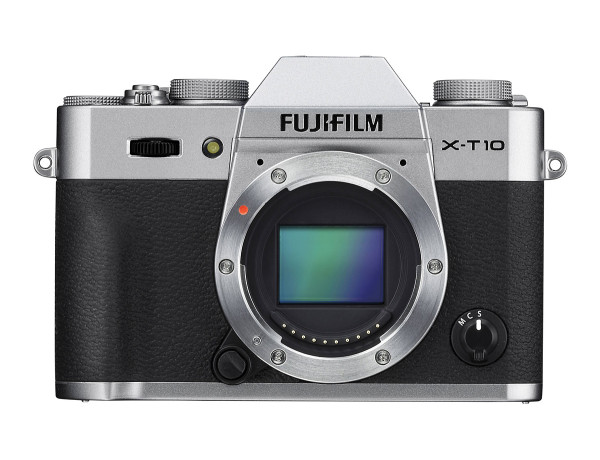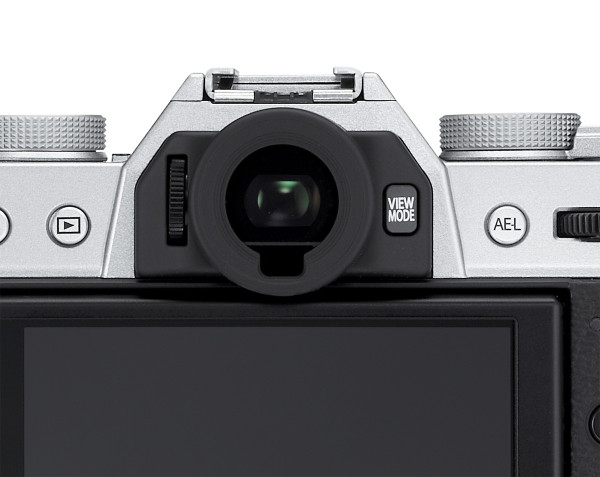Posted by Photo-John on May 24, 2015
I haven’t written much here about Fujifilm’s X-Series mirrorless cameras because they fall into a sort of gray area for me, between smaller mirrorless systems and DSLRs. It’s not that they aren’t good cameras – they’re excellent. They’re just kind of big for my taste. So I was excited to see Fujifilm’s X-T10 camera announcement, earlier this week. The new Fujifilm X-T10 mirrorless camera shares many of the same features as the X-T1 flagship camera, including a built-in electronic viewfinder (EVF) and Fujifilm’s 16.3-megapixel X-Trans II sensor, one of the best APS-C sensors available. However, the X-T10 is considerably smaller and costs hundreds of dollars less than the X-T1. I spent the past week researching the X-T10 and comparing it to other cameras to find out where it fits in and how it measures up.
Although they’re not as small as some mirrorless cameras, Fujifilm’s X-Series cameras are smaller than most DSLRs and arguably have the best image quality you can get from any mirrorless camera, short of Sony’s full-frame A7 bodies. The reason for the excellent image quality is Fujifilm’s X-Trans sensor, which delivers great low-light performance along with a wonderful, subtle tonal quality. Fujifilm’s eighteen Fujinon lenses are also a cut above the rest (until recently, anyway – Sony, Olympus and Panasonic all make pro-level optics for their mirrorless systems, now). Even their entry-level 18-55mm f/2.8-4 kit lens is impressive. The feel and build of the X-Series cameras is special, too – as close to Leica as most of us mortals will ever hope to own.

Fujifilm’s X-T10 has a 16.3 MP APS-C X-Trans CMOS II sensor, the same sensor used in the X-T1 and arguably the best APS-C sensor available right now.
|
Buy the Fujifilm X-T10 From Amazon >>
Using the red “Buy It” links on Photo-John.net helps us keep this Web site up and running. Thanks for supporting Photo-John – tell a friend!
|
 |
So is the Fujifilm X-T10 small enough to get my mirrorless blessing? While it’s true there are smaller mirrorless cameras, most of them have smaller, less capable sensors and don’t have an EVF. To put the X-T10 in perspective, I checked the spec sheets on a range of comparable cameras. The X-T10’s listed dimensions are 118.4 x 82.8 x 40.8mm (4.7 x 3.3 x 1.6in.). That’s about 35% smaller than the Fujifilm X-T1 and just a tad bigger than Sony’s diminutive A6000. It’s less than half the size of the Canon EOS Rebel T5i / 700D, one of the smaller DSLRs on the market. The X-T10 should be able to outperform the T5i in almost every respect, too. As I’ve already said, Fujifilm’s X-Trans sensor is one of the best, if not the best APS-C sensor available, with great dynamic range and excellent low-light image quality. The X-T10 is fast, too. It can capture photos at up to 8 frames per second. Yes, there are faster mirrorless cameras. But 8 FPS is plenty fast. It’s the same frame rate as the original Canon EOS 7D, a camera revered by many sports photographers and one I regularly use to shoot high-speed action sports.
Although the X-T10’s fast burst rate might make it look like a great sports camera, one area where mirrorless cameras still lag behind DSLRs is continuous auto focus. Note that the key word in that sentence is “continuous.” If you don’t know what that is, and you aren’t a sports photographer, it probably doesn’t affect you. But if you are DSLR action shooter, and you rely on continuous auto focus to shoot high-speed, moving subjects, you’ll probably find mirrorless camera auto focus isn’t quite what you’re used to. However, the X-T10 has a brand new 77-point auto focus system with 15 phase detect pixels along with new Zone, Tracking and Eye Detection AF modes (most of the new features are also available for the X-T1 with a firmware update). I haven’t used the X-T10 so I can’t say how well the continuous auto focus and tracking work. But based on all the positive things I’ve heard from X-T1 owners about its auto focus performance, I’d really like to see what the X-T10 is capable of. Check out the video below to see the new X-T10 auto focus features in action.
One of the important benefits of the X-T10 is the electronic viewfinder. Old school photographers used to optical viewfinders will rightfully be skeptical. A few years ago, EVFs were not very good. However, the good ones now are excellent and you might not even realize you’re looking at a tiny LCD display if no one tells you. I actually prefer a good EVF to an optical viewfinder, now. The EVF display is just a miniature version of the rear LCD. That means you can see the histogram and live exposure adjustments as well as make menu changes without removing your eye from the viewfinder. You can even play back photos in the EVF. Once you get used to that, it’s really hard to go back.

The Fujifilm X-T10 has a 2.36-million-dot OLED electronic viewfinder (EVF) for live exposure changes, menu access, movie recording and photo playback without removing your eye from the viewfinder.
If you use your camera for video, you’ll love the X-T10’s EVF. The optical viewfinder on a traditional DSLR is disabled in movie mode and you’re forced to use the rear LCD display. Not so with an EVF – it works just fine when recording video. That’s not just a matter of convenience, either. Putting the camera up to your eye adds a third point of contact, which allows you to record smoother, steadier handheld video without any expensive accessories.
It looks like Fujifilm gave the X-T10 most of same features and performance as their X-T1 flagship camera. The important differences are the X-T10’s new auto focus system, the camera build, the EVF and the buffer. As mentioned earlier, the new auto focus features are all available for the X-T1 with a firmware update. However, the X-T10 does have more AF points and that’s a real benefit for tricky compositions and subject tracking. On the downside, if you do lots of burst shooting, the X-T1 has a much larger 47-shot buffer. The X-T10 can shoot only 8 frames before it has to start saving to the memory card. For serious action photographers that could be a deal-killer.
Although the X-T10 has what looks to be a solid build, with top and bottom magnesium plates and machined metal dials, the X-T1 has a tank-like all-metal body with significant weather-proofing. However, I don’t think weather-proofing is as important as a lot of photographers believe it to be – and I spend a lot of time shooting in the rain and snow.
The last difference is the viewfinder. The X-T1’s EVF is considerably larger with better magnification for less eye fatigue. However, a smaller viewfinder is a compromise I can live with – especially since the X-T10 is so much smaller and lighter.
I hope this intro article helped put the Fujifilm X-T10 in perspective for you. I spent a lot of time digging into the features and specs, and frankly, I’m coming away from this article a lot more interested in the X-T10 than I expected. I loved Fujifilm’s X-E1 when I reviewed it (read my Fujifilm X-E1 review), a couple of years ago. But I felt it was a little big for a mirrorless camera. The X-T1 is even bigger and I just couldn’t get excited about it. As a DSLR replacement, it’s an excellent camera choice. But the new X-T10 appears to offer the best of both worlds. It’s more of what I’m looking for in a mirrorless camera – a truly compact, travel-friendly body with DSLR-like performance. If you’re looking for a travel, walkaround or backpack camera, I think the X-T10 looks like an excellent option. In fact, the X-T10 looks like a great camera for almost anything short of professional sports photography. If you showed up with an X-T10 to shoot a wedding or a commercial photo job, I’d feel fine just about it.
The Fujifilm X-T10 should be available in stores and at online dealers, in June of 2015. The suggested retail price is US $799 – that’s $500 less than the X-T1. It will also be sold in two kit variations, with the XC16-50mm f/3.5-5.6 OIS II zoom lens for $899; or with the XF18-55mm f/2.8-4 R LM OIS zoom for $1099.
|
Buy the Fujifilm X-T10 From Amazon >>
Using the red “Buy It” links on Photo-John.net helps us keep this Web site up and running. Thanks for supporting Photo-John – tell a friend!
|
 |